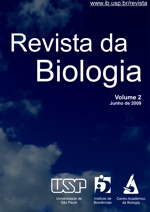An holistic view to river ecosystems
DOI:
https://doi.org/10.11606/issn.1984-5154.v2p8-11Keywords:
Keywords, river ecosystems, rivers, holistic view, assessment.Abstract
The river ecosystem is characterized by great variability and complexity of biotic and abiotic parameters, essentially dynamic, which have a key role in maintaining the quality of life. In this context, this paper deals with some aspects of river ecosystems, emphasizing the importance of adopting a holistic approach as a complementary criterion in assessing the river’s "health". The assessment of rivers with a holistic approach, coupled to classical evaluation criteria (such as physical and chemical parameters - pH, temperature, turbidity, etc.. - and biological parameters), provide information reflecting the true state of river resources.
Downloads
References
Barrella, W., Junior, M. P. L., Smith, W. S. e Montag, L. F. (2001). Matas Ciliares. Conservação e Recuperação. São Paulo: Edusp. Fapesp.
Callisto M., Ferreira W., Moreno P., Goulart M. D. C, Petrucio M. (2002). Aplicação de um protocolo de avaliação rápida da diversidade de habitats em atividades de ensino e pesquisa (MG-RJ). Acta Limnologica Brasiliensia, 14(1), 91-98.
Frissell, C.A., Liss, W.J., Warren, C.E. e Hurley, M.D. (1986). A hierarchical framework for stream habitat classification: viewing streams in a watershed context. Environmental Management, 10, 199-214.
Landesumweltamt (LUA). (1998). Merkblätter nr.14. Germany: Gewässerstrukturgüte in Nordrhein-Westfalen Kartieranleitung (GNWK).
Minatti-Ferreira D. D. e Beaumord A. C. (2006). Adequação de um protocolo de avaliação rápida de integridade ambiental para ecossistemas de rios e riachos: Aspectos físicos. Revista Saúde & Ambiente, 7(1), 39-47.
Parsons, M., Thoms, M. e Norris, R. (2002). Australian River Assessment System: AusRivAS Physical Assessment Protocol. Canberra: Commonwealth of Australia and University of Canberra.
Rodrigues, A. S. L. (2008). Adequação de um protocolo de avaliação rápida para o monitoramento e avaliação ambiental de cursos d’água inseridos em campos rupestres. 2008. 146 f. Universidade Federal de Ouro Preto, Dissertação de Mestrado.
Rodrigues, A. S. L. e Castro, P. T. A. (2008). Protocolos de avaliação rápida: instrumentos complementares no monitoramento dos recursos hídricos. Revista Brasileira de Recursos Hídricos, 13(1), 161-170.
Schwarzbold, A. (2000). O que é um rio? Ciência & Ambiente, 21, 57-68.
Silva, M. e col. (2007). Futuro Sustentável. Diagnóstico de Ambiente do Grande Porto. Disponível em: http://www.futurosustentavel.org. Acessado em 10 de abril de 2007.
Silveira, M. P. (2004). Aplicação do biomonitoramento para Avaliação da Qualidade da Água em Rios. Jaguariúna: Embrapa Meio Ambiente.
Upgren, A. (2004). The Development of an Integrated Ecological Assessment of the Headwaters of the Araguaia River, Goiás, Brazil. University of Duke, Dissertação de Mestrado.
Ward, R.C. (1967). Principles of Hydrology. New York: Graw-Hill Publishing.
Zalewski, M. e Robarts, R. (2003). Ecohydrology – A New Paradigm for Integrated Water Resource Management. Sil News, 40, 1-5.
Downloads
Published
Issue
Section
License
Copyright (c) 2009 Aline Sueli de Lima Rodrigues

This work is licensed under a Creative Commons Attribution 4.0 International License.
We ensure that our journal does not retain any copyright and that these are exclusive of the author(s) of the text. In that sense, we intend to break any restrictions to the published material and to achieve more intensely our goal of communicating science.






